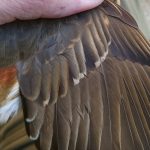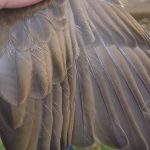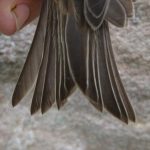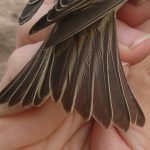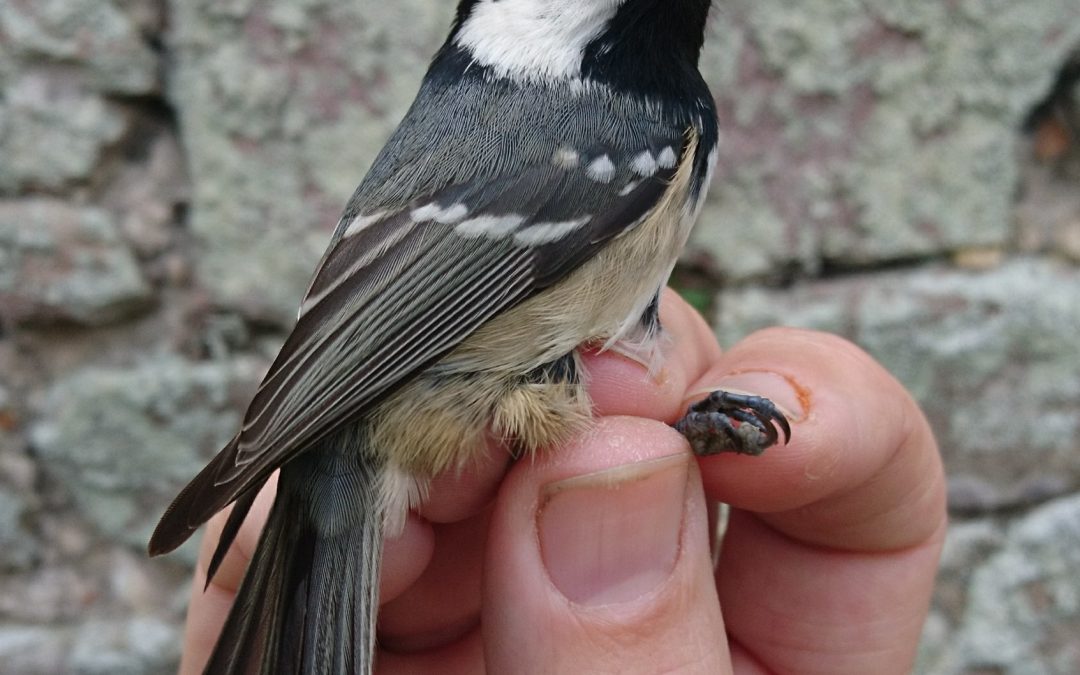
by John Horton | Nov 29, 2017
A windy week saw the phenomenal numbers of migrant birds this autumn finally fade to trickle. Even so late movements continue with small numbers of Chiffchaffs, Blackcaps and Firecrests passing through. Winter wildfowl records are always at a premium here bar a few sporadic Teal but a Wigeon dropped in as the weather got colder at the end of the week.
21st – SW winds, still a few migrants moving over Mannez, 2 Bramblings, around 50 Redwings and 5 Fieldfares over. Ringing was low numbers but included Fieldfare and Reed Bunting. On the falling mid-day tide 2 Sanderlings in Longis Bay. In the afternoon another addition to our annual ringing list at Essex farm by way of 2 Coal Tits, surprisingly not resident here, the island appears to see just a handful of this species during migration only.

Coal Tit – Essex Farm – photo – JH/ABO
23rd – An unseasonal Common Sandpiper on Braye beach was joined by the still present Water Pipit.
24th – 4 Meditteranean Gulls and 2 Grey Plovers in Braye Bay where a bull Grey Seal put in a brief appearance. Ringing at Rose farm included 3 Firecrests and 6 Chiffchaffs one of which was UK ringed bird. Some movement over rose farm with 12 Skylarks and 200+ Chaffinches. A Grey Wagtail and White Wagtail shared the sewage works at Essex. Paul & Catherine Veron had a Bullfinch and Siberian Chiffchaff in their garden and in Longis bay 5 Turnstones, 2 Sanderlings and a Great White Egret.
25th – A Black Redstart in Braye Harbour, 4 Long tailed Tits by the Watermill. The Water Pipit was in Longis beach car park and 6 Kittiwake were seen off Mannez.
26th – A single Snipe and a Wigeon on Longis pond where the long staying Little Grebe is still present.
The Nunnery building (our HQ) continues to be coming along well, the new roof tiles about to go on.
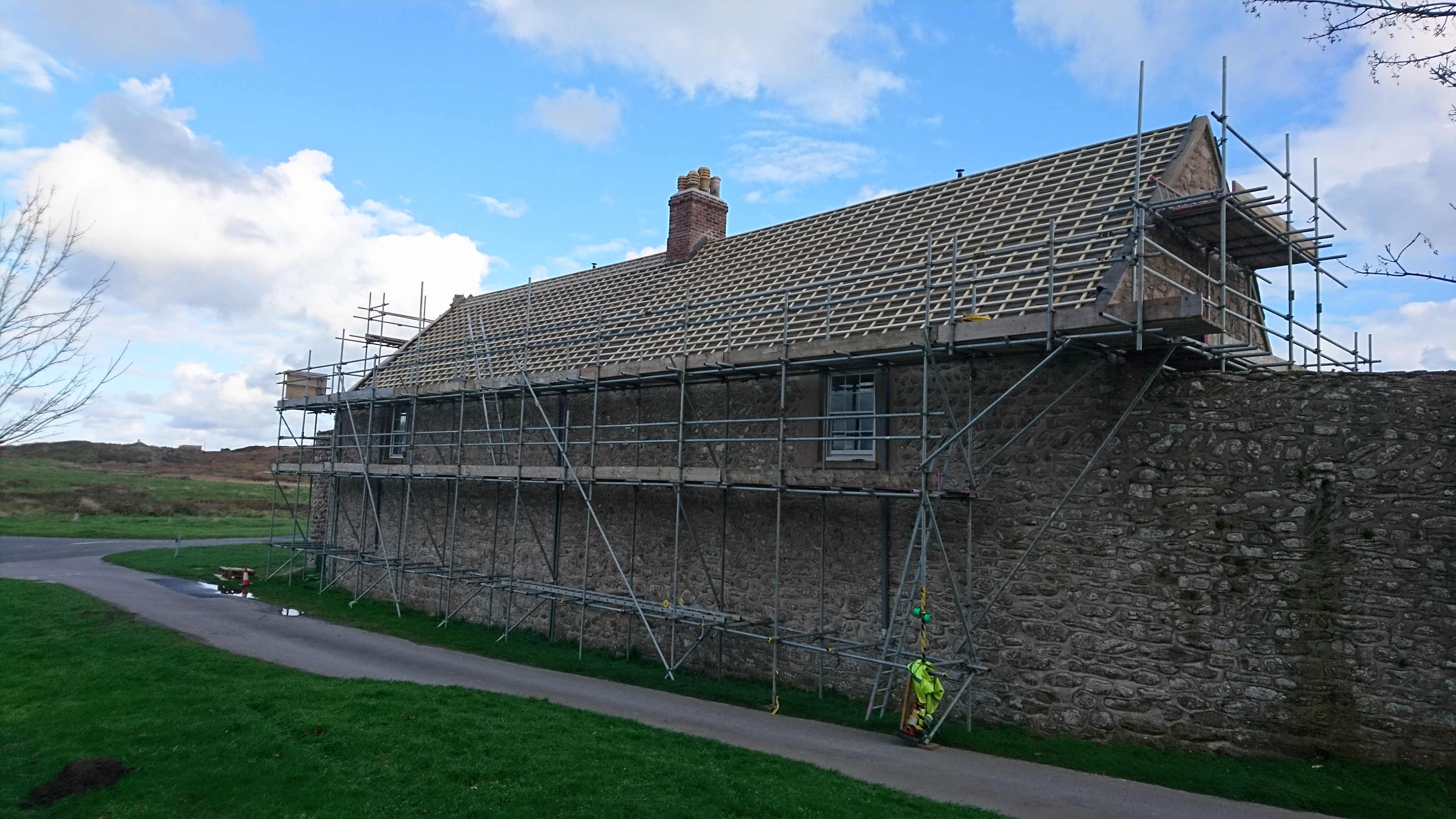
The Nunnery – ABO HQ – Photo – JH/ABO
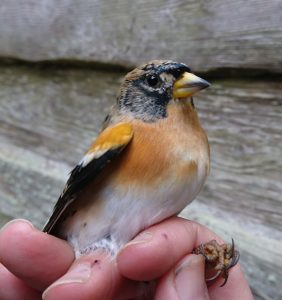
by John Horton | Nov 20, 2017
13th – After two days of strong gales overnight Northerly winds brought in a further deluge of Thrushes and finches. Ringing totalled 118 birds, Redwing dominated figures again with 50, other highlights were 4 Fieldfares, 5 Bramblings, 1 Bullfinch and a Sparrowhawk. The total also incorporated the 3000th Blackcap ringed since the ABO began in the spring of last year. In the afternoon a fine Water Pipit showed well feeding in the outflow just below the Longis car park jetty and 20 Siskins were seen in Barrackmasters Lane.
14th – Without any other committments I was all set for a dawn til dusk ringing session at Mannez quarry. I wasn’t expecting too much given the overnight and continuing westerly winds, I was wrong ! It was another of those amazing migration days, throughout the morning mixed flocks of Chaffinches and Bramblings some over 100 strong. Starlings and Redwing flocks well into the hundreds! Also a single Ring Ouzel, a handful of Skylarks and Siskins passing overhead. Mid afternoon a Short eared Owl hunted the quarry sending Thrushes in all directions. Ringing with trainee John Wier (nice job John) we returned 141 new birds, 88% of them from 3 species, 78 Redwings, 29 Chaffinches, 17 Bramblings. Also 5 Blackbirds, 4 Song Thrushes, 2 Blackcaps, 1 Chiffchaff, 1 Firecrest and 4 Siskins.
The chance to experience 17 Bramblings in one session does not come along too often so it was a great opportunity to look at some of the identification criteria.

Adult male Brambling – Mannez quarry – photo – JH – ABO
Old Greater Coverts (OGC’s) are fairly easy to see on Bramblings (easier than on Chaffinches at least). Photo below of a first winter male brambling showing the two outer unmoulted greater coverts (more brown with buff/white leading edge and tips) against the inner moulted greater coverts ( black with orange tips).
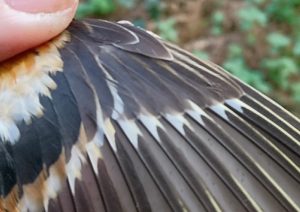
1st winter male Brambling wing – Mannez quarry – photo JH/ABO
It was however the tail that stood out as the most obvious ageing indicator. Tail feathers of course should not be taken as the only pointer towards ageing in case they have been replaced, but the more birds we did, it became clear this can be very useful. The photos below are both from male Bramblings though the same features extend to females. An adult on the left and 1st winter on the right. TF1 , (the two central tail feathers) have black centres on the adult (left) and have quite rounded tips. The first year bird on the right has very little black, especially towards the tips which are rather grey and sharply pointed. There is not a lot to separate tail feathers 2-6 on either bird, though the adult tail feathers are broader both birds have pointed tips, the adult to a lesser extent, but unless you are lucky enough to catch an adult and juvenile together for direct comparison, looking for pointed tips to TF2-6 is probably not too helpful.
-

-
Adult male
-
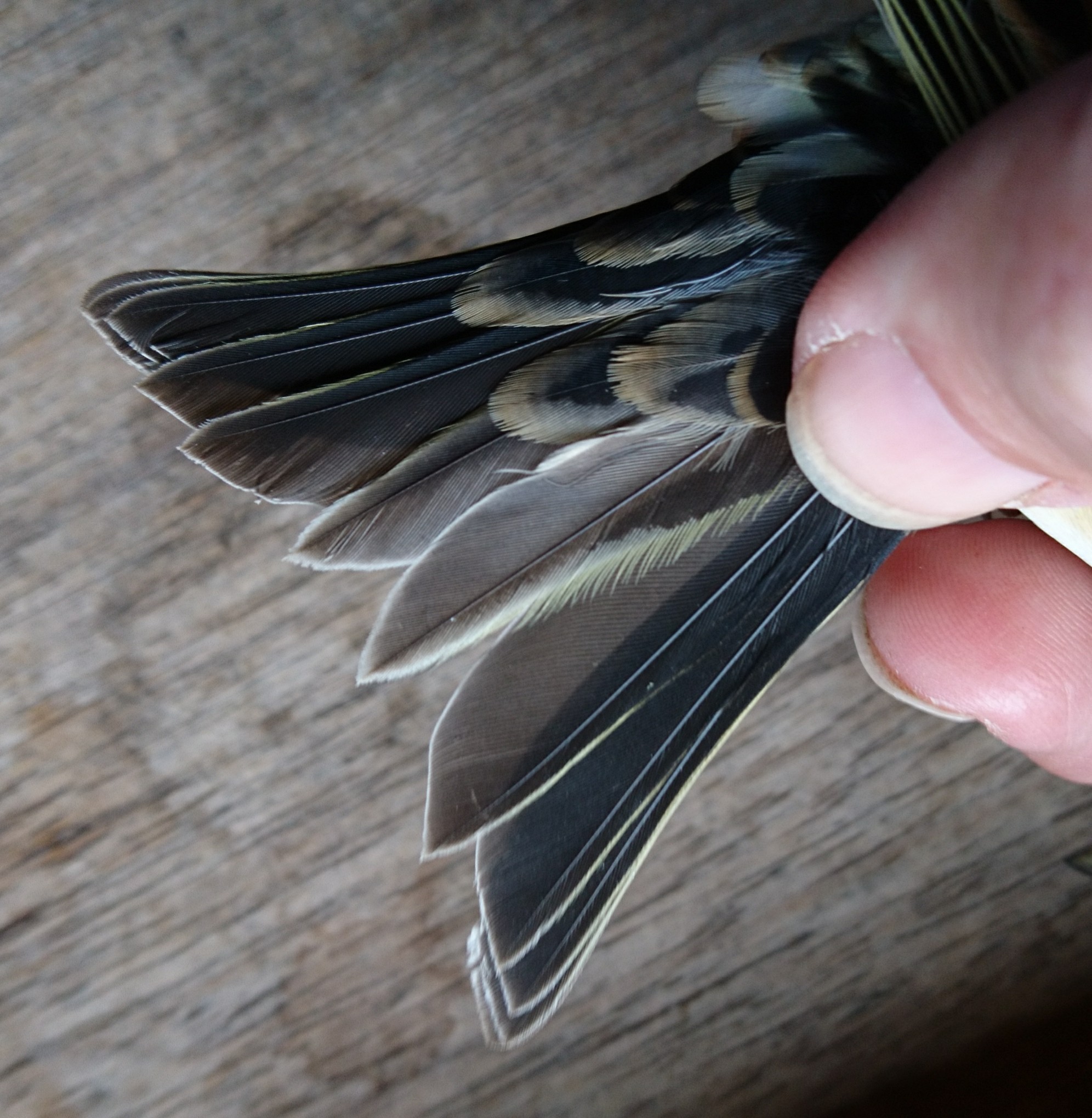
-
1st winter male
In general the new Demongin guide has been very useful for several species, we did not find the suggested pattern of the mantle feathers to be useful for ageing Bramblings as there is considerable variation. Though the guide does say “use with caution”.
15th – West winds continued overnight and throughout the day. Another Hawfinch was seen in Barrackmasters Lane. Ringing at Mannez produced another 8 Bramblings and further singles were ringed at Barrackmasters lane and Essex farm. A big surprise was a Great Northern Diver flying SW overland along the south coast from Mannez lighthouse towards Longis bay.
16th – A new wave of migrants in overnight, still dominated by starlings, thrushes and finches but also Firecrests, Chiffchaffs and Blackcaps. At Rose farm 4 new Firecrests took us over 400 of this species ringed since we began in April last year. It continues to be a good year for migrant Bullfinches with another first winter female ringed. We also ringed our first Moorhen this year. There was a late movement of Chiffchaffs that included 10 ringed at Rose farm and a small party of 5 Long tailed Tits headed down the Bonne Terre Valley. A Coal Tit was seen in Barrackmasters Lane,
17th -NE overnight and once more a rush of Thrushes through. It’s frustrating to witness so many birds moving and have just 1 of our 4 main ringing sites manned but hopefully all that will change next year once we are officially open with our new observatory accommodation housing mad keen ringers ! A silver lining came by way of a call from a local resident that a Snow Bunting (photos below) had been seen in the small rough ground car park leading to Saye beach. I was delighted the bird was still present and a typically tame individual as is often the case with this species. Returning back to the Obs there was a Black Redstart on our north wall and from the ringing room I noticed the Water Pipit back on the longis car park jetty. Paul and Catherine Veron had 3 Woodlarks flying over the IMPOT fields.
-
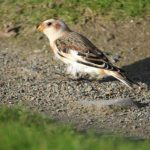
-
Snow Bunting – Saye Bay
-
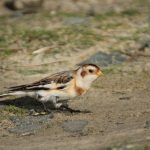
-
Snow Bunting – Saye Baye
18th – Another large thrush and finch movement. Redwings galore, flocks of Chaffinches and Starlings passing over Mannez reserve from first light until mid day. A Woodcock flushed from the pathway near to the Mannez hide. 122 birds were ringed at Mannez again mostly Redwings and Chaffinches but also singles of Firecrest, Chiffchaff and Reed Bunting.
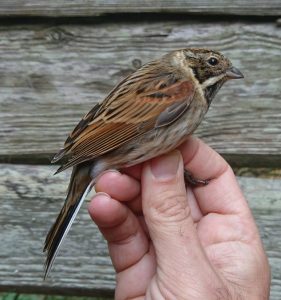
Adult male Reed Bunting – Mannez quarry – photo – JH/ABO
19th – With NE winds and showers overnight it looked promising for another influx of migrants. We have got used to birds in their thousands this autumn but this morning was a comparatively quiet affair. Even so, 6 new Firecrests, a Brambling and a Tristi’s Chiffhchaff were amongst the birds ringed so hardly room for complaint. Late on 2 Sandwich Terns fishing in Longis Bay.
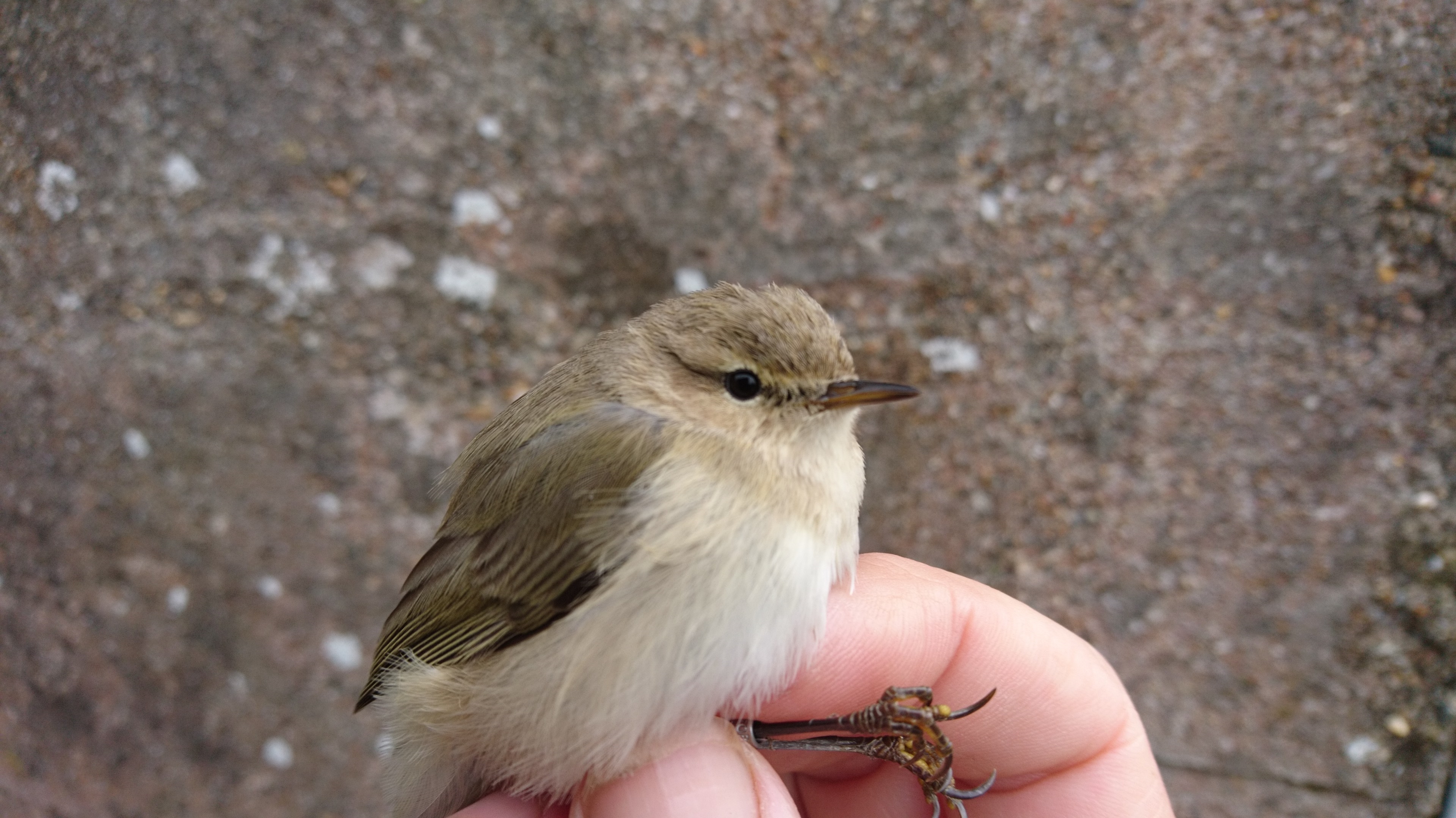
Tristi’s Chiffchaff – Rose Farm – photo – JH/ABO
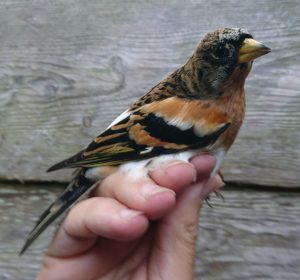
by John Horton | Nov 15, 2017
6th – A crisp, fresh and windless morning saw flocks of Thrushes and Finches passing through and over Mannez quarry reserve. I flushed up 4 Woodcocks whilst opening the ringing nets just prior to first light. A female ring Ouzel showed well feeding amongst the Blackthorn with Redwings and Fieldfares. Finch flocks of up to 100 Chaffinches at a time passed over with Bramblings amongst them. Two separate flocks came into the quarry that were made up of Bramblings only (11 & 23 birds respectively). A male Reed Bunting flew over and shortly after we ringed a first year female. Amongst 88 birds ringed were large female Sparrowhawk, 1 Lesser Redpoll, 19 Redwings and 31 Chaffinches. As a finches fan I have been thoroughly spoilt this autumn and was delighted to ring 13 Bramblings today. A further 5 Bramblings were ringed at Longis nature reserve and Paul Veron ringed a further Brambling in Barrackmasters Lane.

Brambling – Mannez -photo JH/ABO
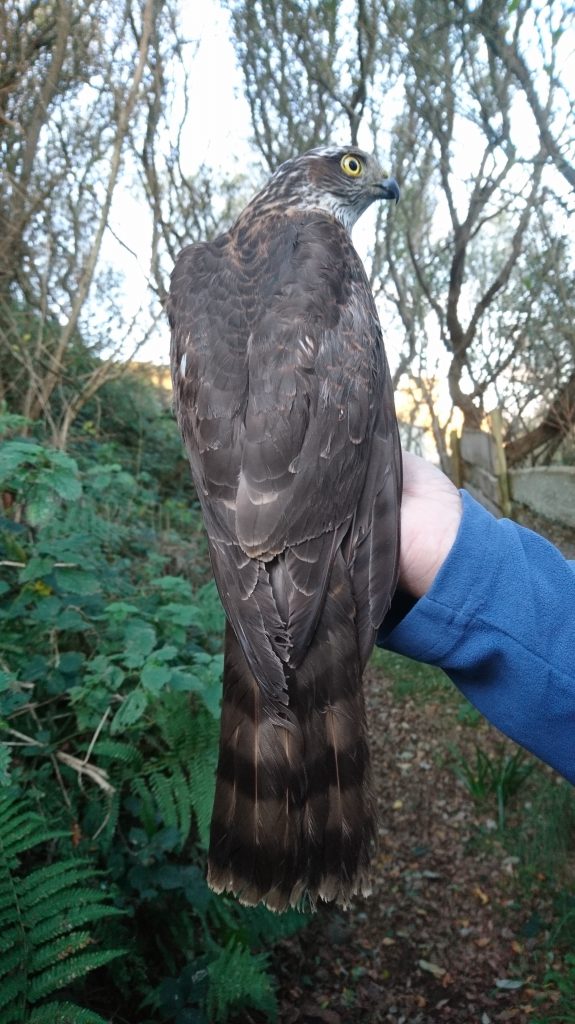
1st winter female Sparrowhawk – Mannez – photo – JH/ABO
7th – Strong SW winds left us with only Mannez available to ring below its sheltering walls. 60 birds were ringed, mostly Thrushes; 43 Redwings, 5 Song Thrushes, 3 Blackbirds and 1 Ring Ouzel.
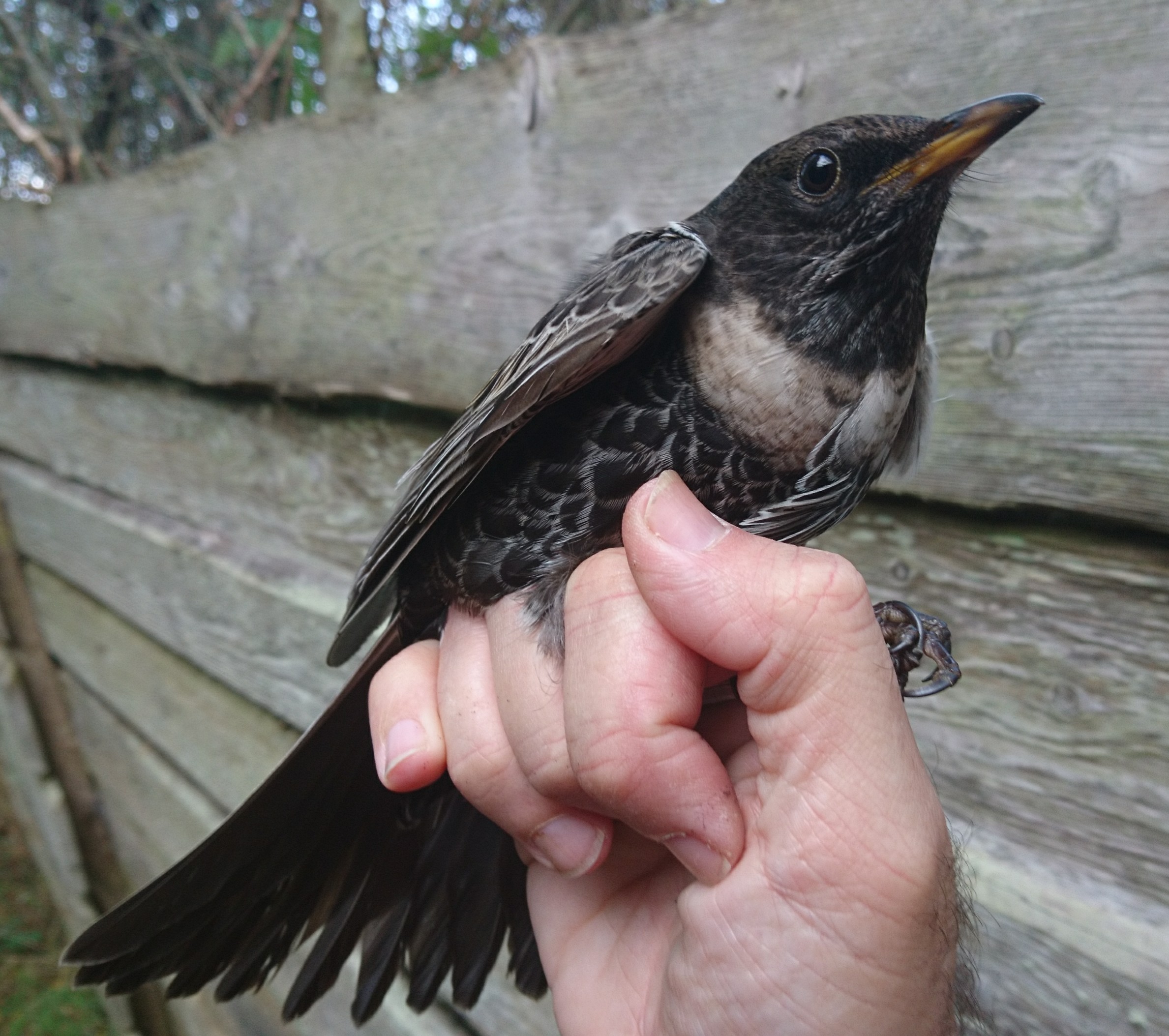
Ring Ouzel Mannez quarry – photo – JH/ABO
8th – SW winds turned to NW overnight, another blowy morning allowing just a couple of nets open. 39 Birds were subsequently ringed at Mannez quarry, again the vast majority thrushes, 31 Redwings and 1 Fieldfare. A couple more Woodcock in the quarry first thing. 2 Sandwich Terns in Longis Bay. Late afternoon a productive 2 hrs ringing using 2 nets at Essex farm 21 new birds included 3 Redwings, 1 Siskin, 1 Brambling, 3 Firecrests and 8 Long tailed Tits.
9th – Rain until around 9am but then a flurry of birds moving included 2 Yellow-browed Warblers ringed, one at Rose Farm, the other Barrckmasters Lane. A woodcock flushed up from the footpath to Mannez hide from which a single flock of 11 Siskins was observed. A male Bullfinch, Siskin and Brambling were seen at Rose farm where a trickle of late moving migrants were ringed including 3 more Firecrests, Blackcap and Chiffchaff. The Lesser black-backed Gull was back on Crabby beach.
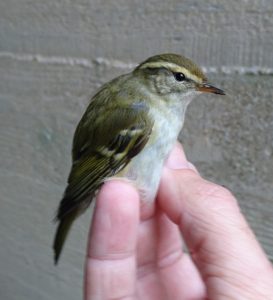
Yellow-browed Warbler – Rose Farm – photo JH – ABO
10th – A blustery day of NW winds. We can always fall back on the nets at Essex farm in this wind direction and this afternoon 19 new birds were ringed that included 3 Chiffchaffs, 2 Bullfinches and a Firecrest.
11th – An awful morning of 40mph NW winds turned into a bright breezy afternoon. There were 11 Turnstones and 4 Ringed Plovers beside the Razz causeway. 22 Mallards on Corbletts quarry. Renovations at the Nunnery are coming along, a new roof for one of the out buildings almost complete. A new roof for the main obs building to follow !
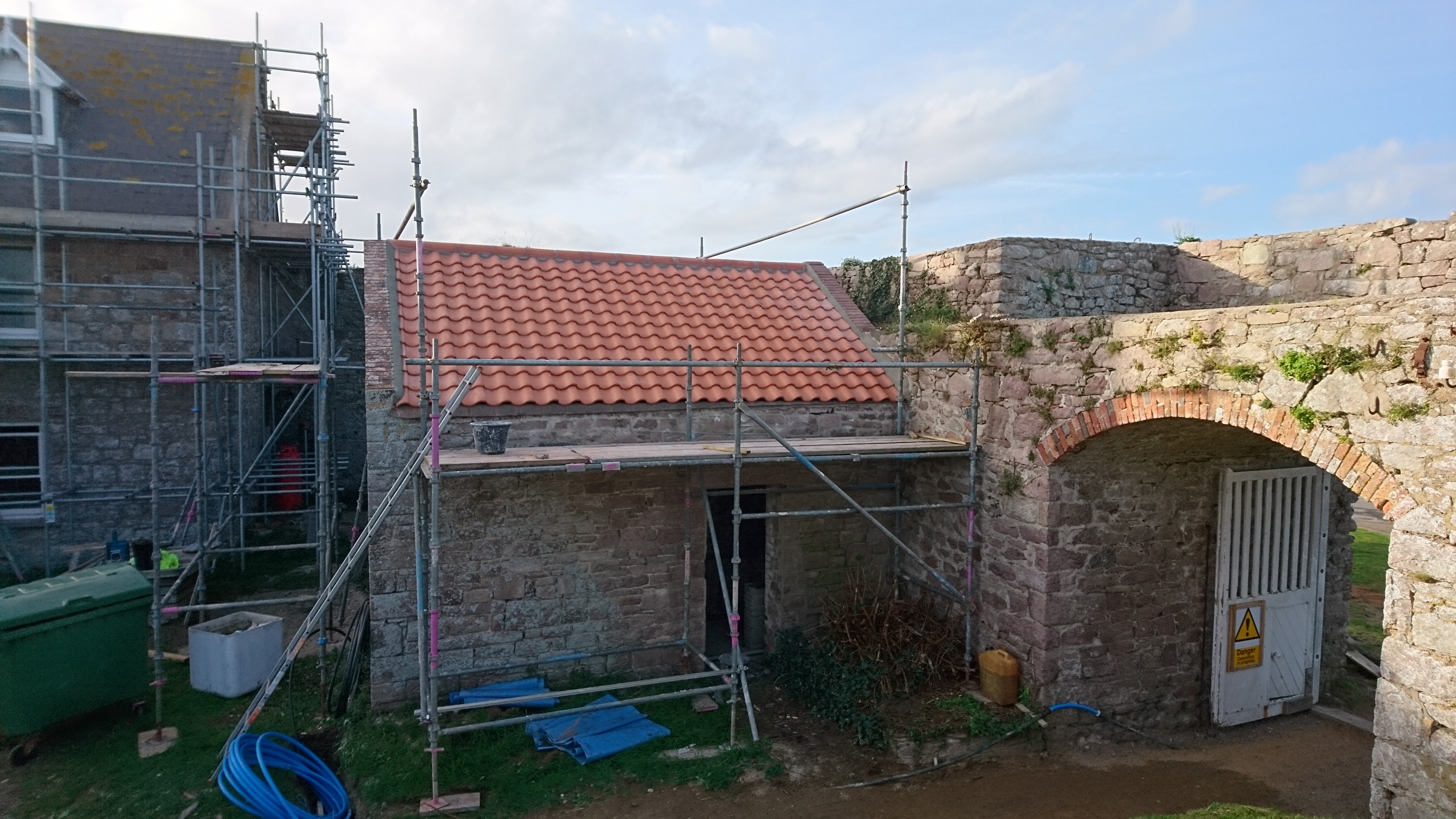
Nunnery renovations – photo – JH – ABO
12th – 30+ NW winds all day, a bit of everything in between, sunshine, rain and hail! There was a gathering of over 130 Herring Gulls in the fields behind Kiln Farm with 3 Lesser black backed Gulls amongst them. Still Chaffinches around with flocks of 30 at Kiln farm, 12 by the goats field and 20 at Rose Farm. By Razz causeway 15 Turnstones, 9 Ringed Plovers and a White Wagtail. 2 Sandwich Terns in Longis Bay and a further 3 in Braye bay. The bird feeding station was very busy (perhaps due to the colder weather) amongst the many Tits and finches a male Brambling. Justin and I did a late afternoon sea-watch for an hour from chateau Le Toq, there was a lot of movement with a fairly constant stream of auks (75) and Kittiwakes (35). We checked Longis pond just before dark there were 2 Teal and 1 Little Grebe on the pond and a flock of 26 Fieldfares came in to roost.
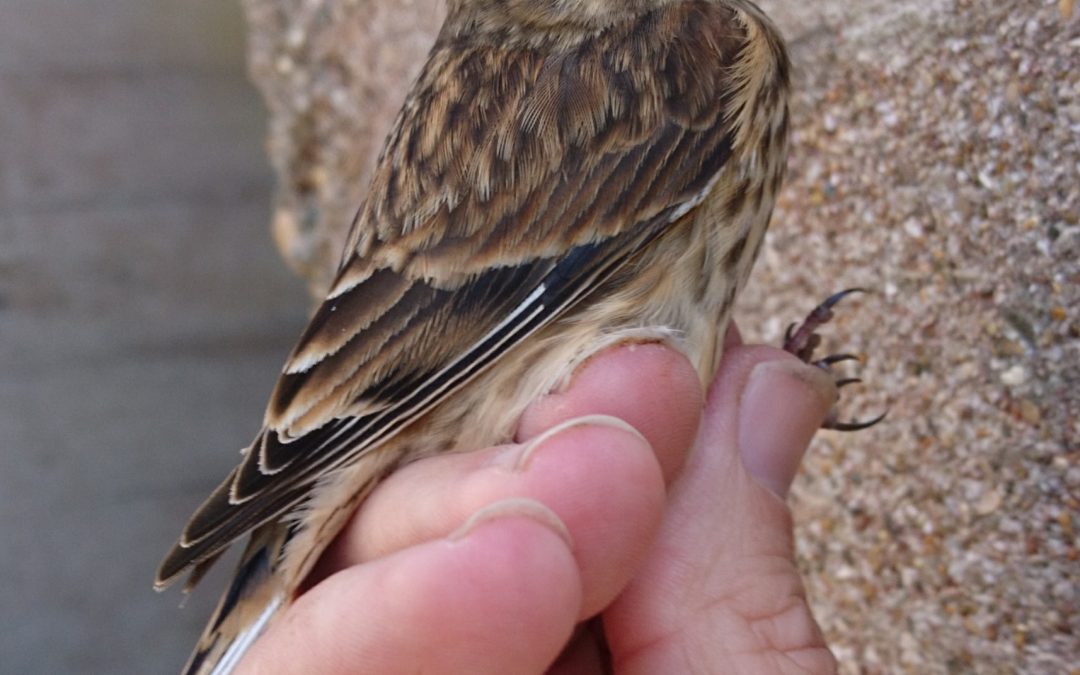
by John Horton | Nov 7, 2017
Another superb week as follows..
30/10 – At Mannez a Great white Egret, the Penduline Tit still in residence, also seen, 2 Ring Ouzels and 3 Hawfinches, 18 Skylarks and 500+ Fieldfare. At least 2 Water rails in the reed bed. 248 birds were ringed today including 48 Redwings at Mannez, a Ring Ouzel was ringed at Longis common where a Mistle Thrush passed overhead. At Essex farm our first ever ringed Common Redpoll. At Rose Farm ringing involved 118 new birds that included Linnet, Bullfinch, Brambling, Siskins, Fieldfare and Firecrests.
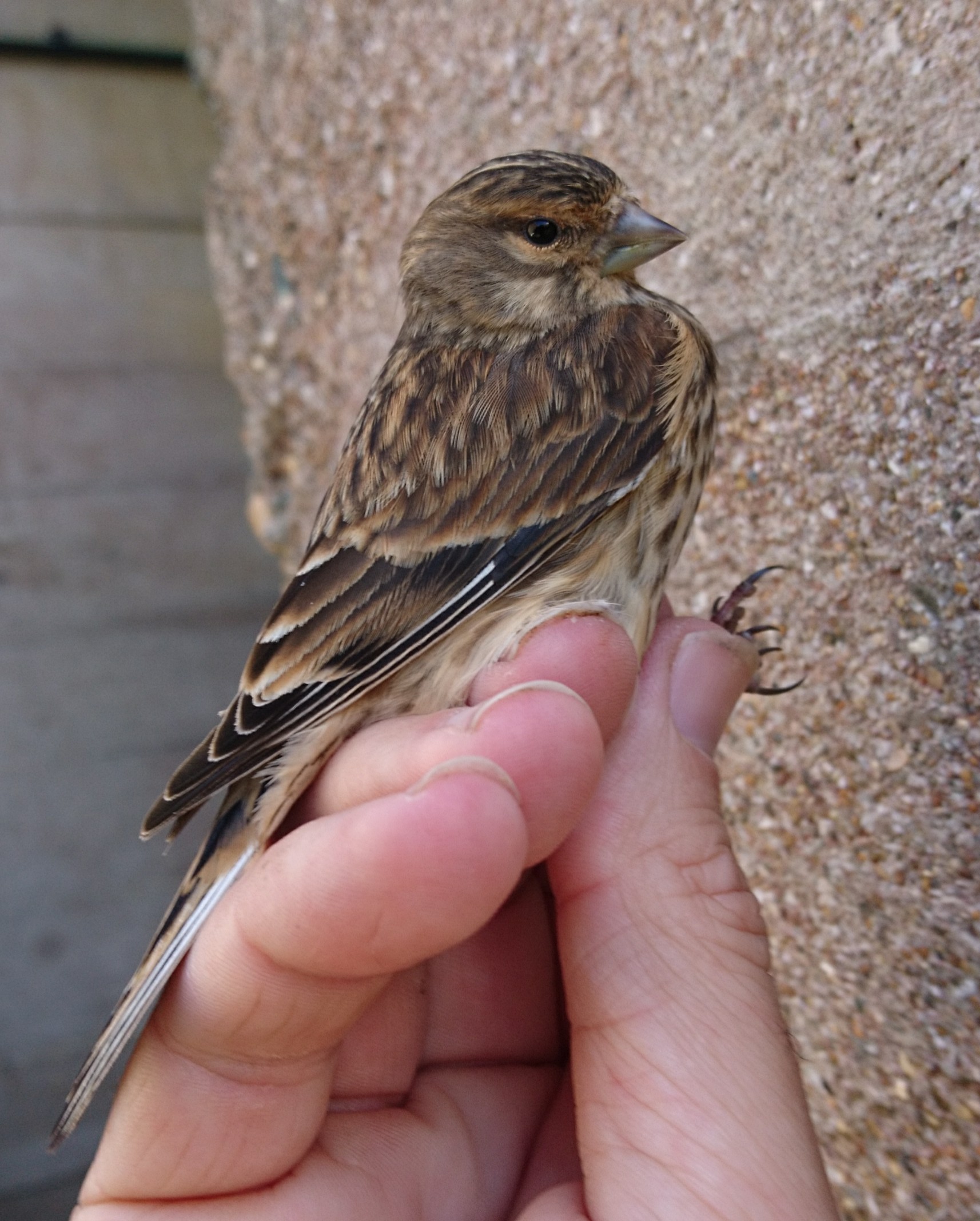
Linnet – Rose Farm – photo – JH- ABO
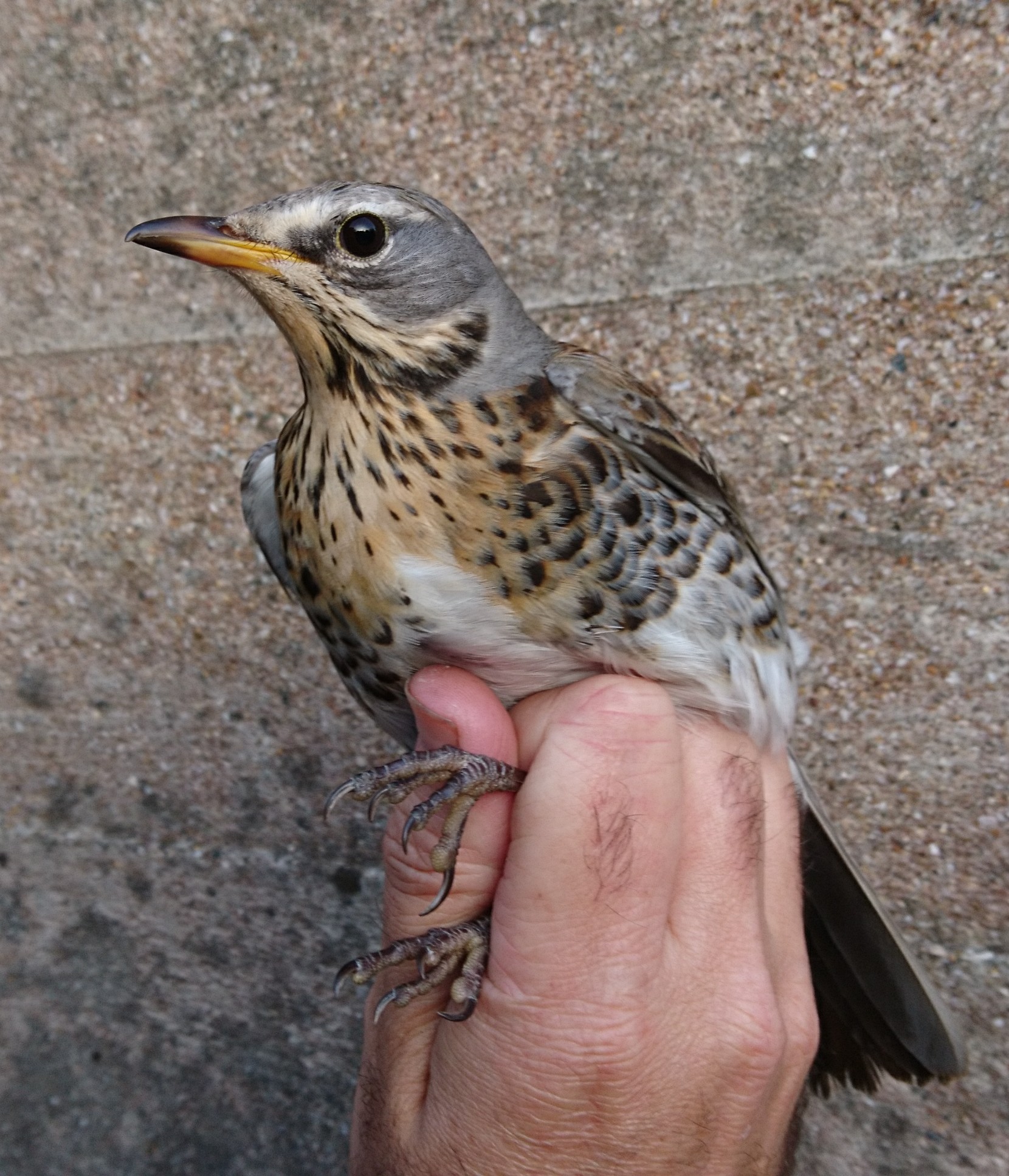
Fieldfare – Rose farm orchard – photo – JH – ABO
31st – A Short eared Owl hunted Mannez quarry at first light where a Ring Ouzel also later showed well. Visual migration at Mannez was dominated by finches, 300+ Chaffinches and 12 Bramblings passing overhead. 112 new birds were ringed at Mannez and these included a Reed Bunting, 2 Bramblings, 3 Firecrests, 4 Fieldfares, 26 Redwings, 1 Bullfinch and 45 Chaffinches. 18 Ringed Plovers and 1 Sanderling occupied the Razz causeway as it was revealed by the dropping tide. From the obs ringing room we observed a large Bull Grey seal that spent a good hour shadowing a lucky chap spear fishing in Longis bay.
1st Nov – Light SE winds overnight turned SW by first light. 2 woodcocks had settled in Mannez quarry and as the light came up once again we were treated to the steady flow of flocks of birds coming in off the sea past the light house, over and into the quarry nature reserve. Ringing at Mannez produced another 90 new birds including 42 Chaffinches, 2 Hawfinches, Cetti’s Warbler, 2 Bramblings, an extremely late moving Garden Warbler and a Chiffchaff carrying a Denmark ring ! Field observations during ringing were of a further 5 Bramblings, 20 Skylarks, 2 further Hawfinches and a Ring Ouzel. Some 500 Chaffinches came in off the sea along with regular flocks of Redwings and Fieldfares, over 1000+ of the former were recorded.
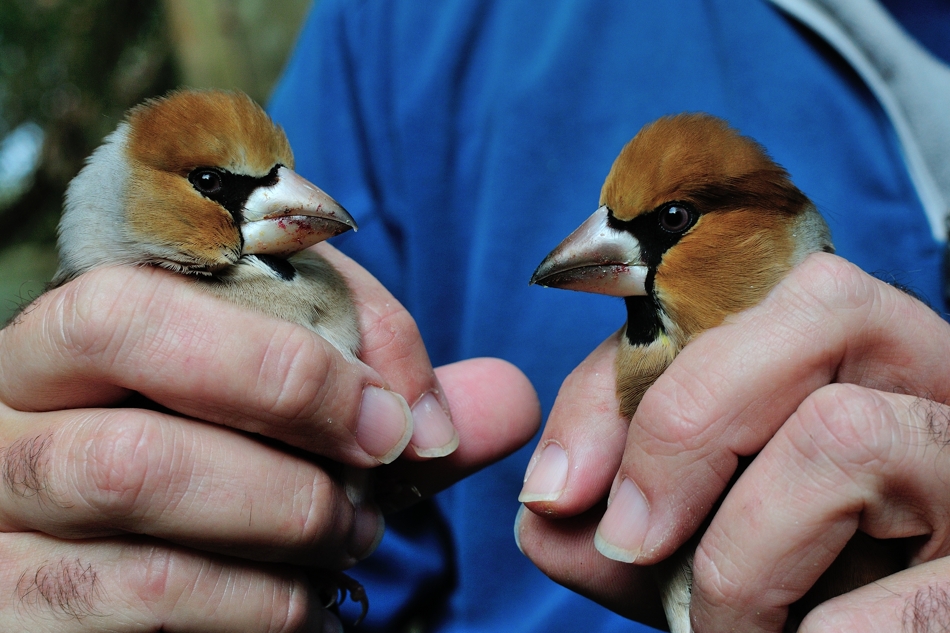
Hawfinches ringed at Mannez Nature reserve – photo – Justin Hart.
2nd – Singles of Ring Ouzel, Hawfinch and Fieldfare were ringed at Mannez by Paul and Catherine Veron. A Grey wagtail over Rose farm and another over the obs. A Bullfinch and 4 Siskins were ringed at Rose farm where visible migration included 10 Skylarks and 5 Bramblings. In Braye bay the Mediterranean Gull roost was 9 birds accompanied by 2 Grey Plovers.

Ring Ouzel – Mannez quarry – photo – Paul Veron
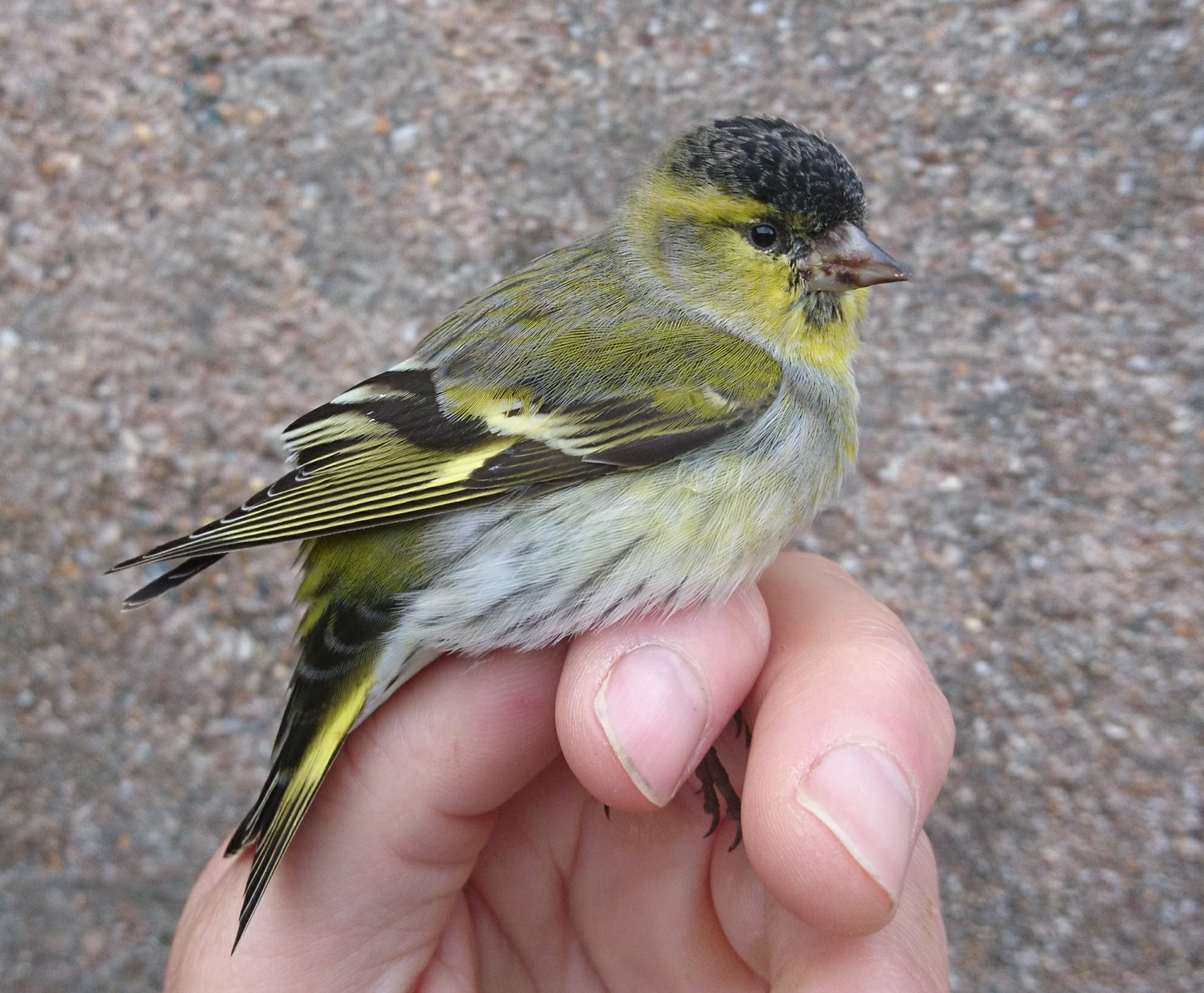
Siskin (male) Rose Farm – photo – JH – ABO
3rd – First thing 3 Grey Herons left a roost position at the north end Longis Pond, at the same time 16 Little Egrets left longis bay which hosted 16 Mallards. On Longis pond 2 female Teal. Ringing at Longis saw our first Woodcock of the year. In the afternoon an hours ringing at Rose farm orchard produced a Bullfinch and a Swallow passing over. A single Common Gull was amongst 19 Med Gulls on Braye beach. After a slower day for migration yesterday, there were more Thrushes moving this morning along with finches, warblers and crests returning 91 new birds ringed.
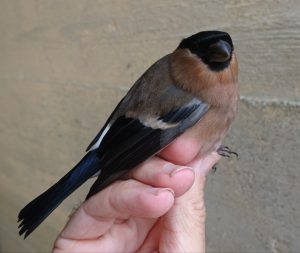
Bullfinch – Rose Farm – photo- JH-ABO
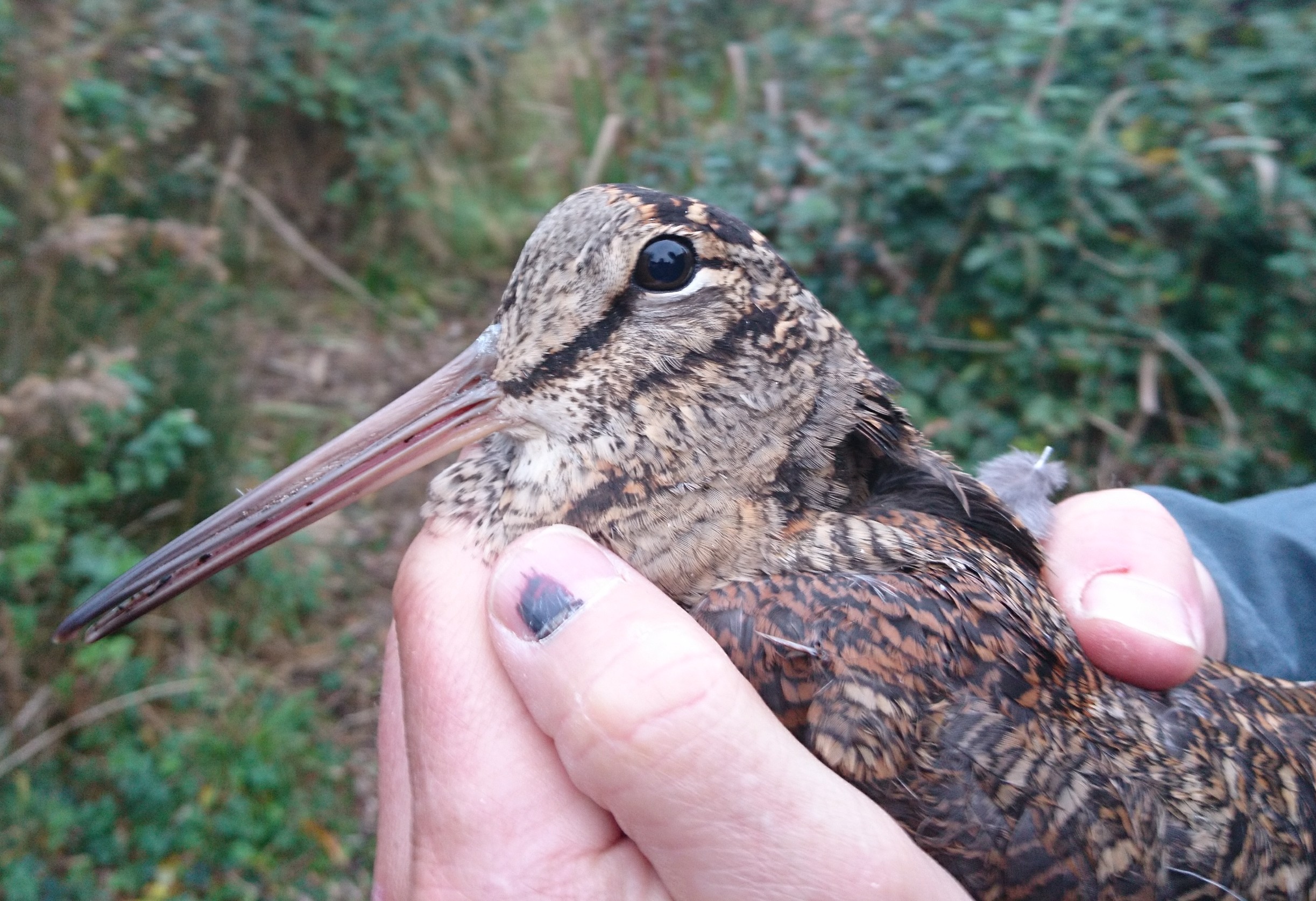
Woodcock – Longis Common – photo – JH – ABO
4th – 30mph NW winds. An early look on the sea off Mannez lighthouse produced a few auks moving and our first Brent Goose of the winter. On Crabby beach a Lesser black backed Gull and 40 Black headed Gulls. Near the airport in the ploughed field opposite the goats were 60 Chaffinches and a fine male Brambling, 3 Stock doves and 26 Skylarks. David Child had a late Swallow over Longis bay.
5th – Again 30mph NW winds during the morning. 65 Black headed Gulls on Crabby beach no sign of the Lesser black backed. Again a nice flock of Chaffinch in the field opposite the goats near to the airport, around 40 today but still a single Brambling in the flock, not yesterdays male, this one a female. During the afternoon a couple of hours ringing in the shelter of Essex hill. Just a handful of birds but a nice variety included Firecrest, 3 Redwings, Song Thrush, 4 Chaffinches and 2 Bramblings. A Water rail was present in the gulley behind the sewage works. Late afternoon 2 Sandwich Terns in Longis Bay and a Grey Seal in Braye Bay. A Marsh Harrier was seen over Barrackmasters Lane.
As we head towards 400 Redwings ringed this autumn opportunities have been available to photograph some identification features regards ageing. The two shots below are of particularly obvious individuals ( many are not as obvious as these!) but these are a good illustration of some of the differences to look for when ringing. The photo on the left a first winter bird showing predominantly unmoulted greater coverts with a pale spot on the corner. The photo on the right is an adult with all the greater coverts moulted and uniform without the pale edges. Whilst the unmoulted tertials on the juvenile bird have pale fringes extending up the shaft of the feather a little, and the adult tertials no pale edge at all, we have not found this to be the most reliable of ageing features as it is quite variable.
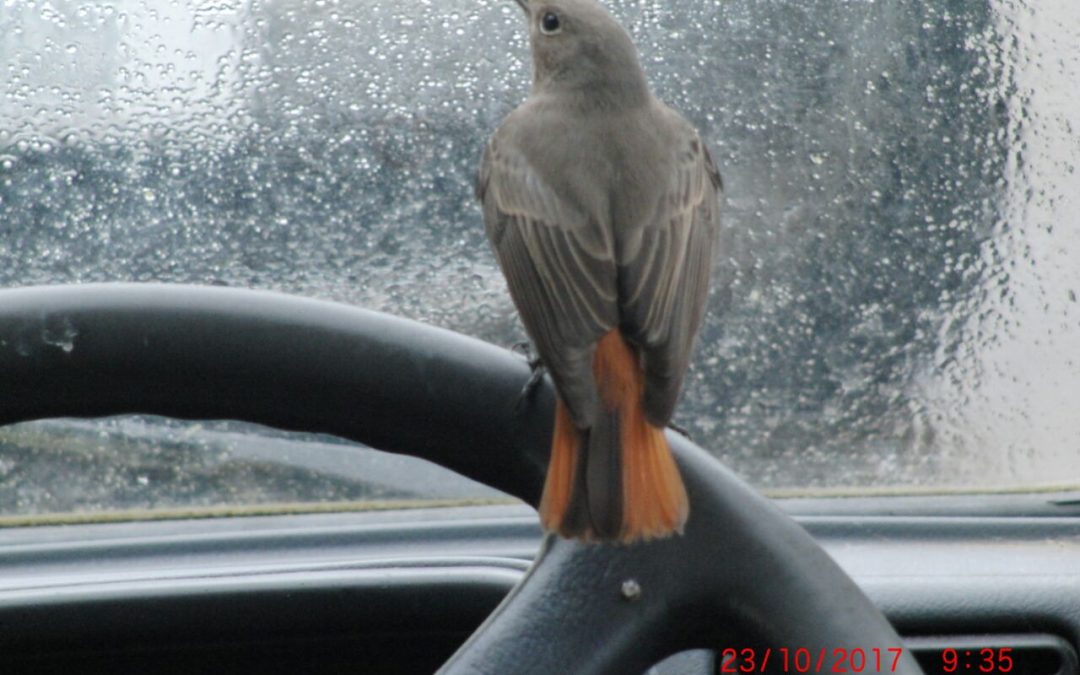
by John Horton | Nov 2, 2017
A fantastically busy week of thousands of birds passing through, amazing birding and ringing experiences that only islands such as this can offer. Though the week began with storm force conditions we went on to benefit from the odd spell of North and North-east winds that brought us bird migration at its best. Over 5 straight days and despite limited resources, over 1000 birds were ringed. Towards the end of the week invasions of Redwings and Chaffinches brought with them Bramblings and Hawfinches along with some more unusual vagrants.
23rd – A House Martin in Longis Bay along with a handful of Swallows. June and Nigel Visard got into their van this morning and sheltering from the stormy conditions this wonderful Black Redstart that appeared to be happy to share the dry conditions.
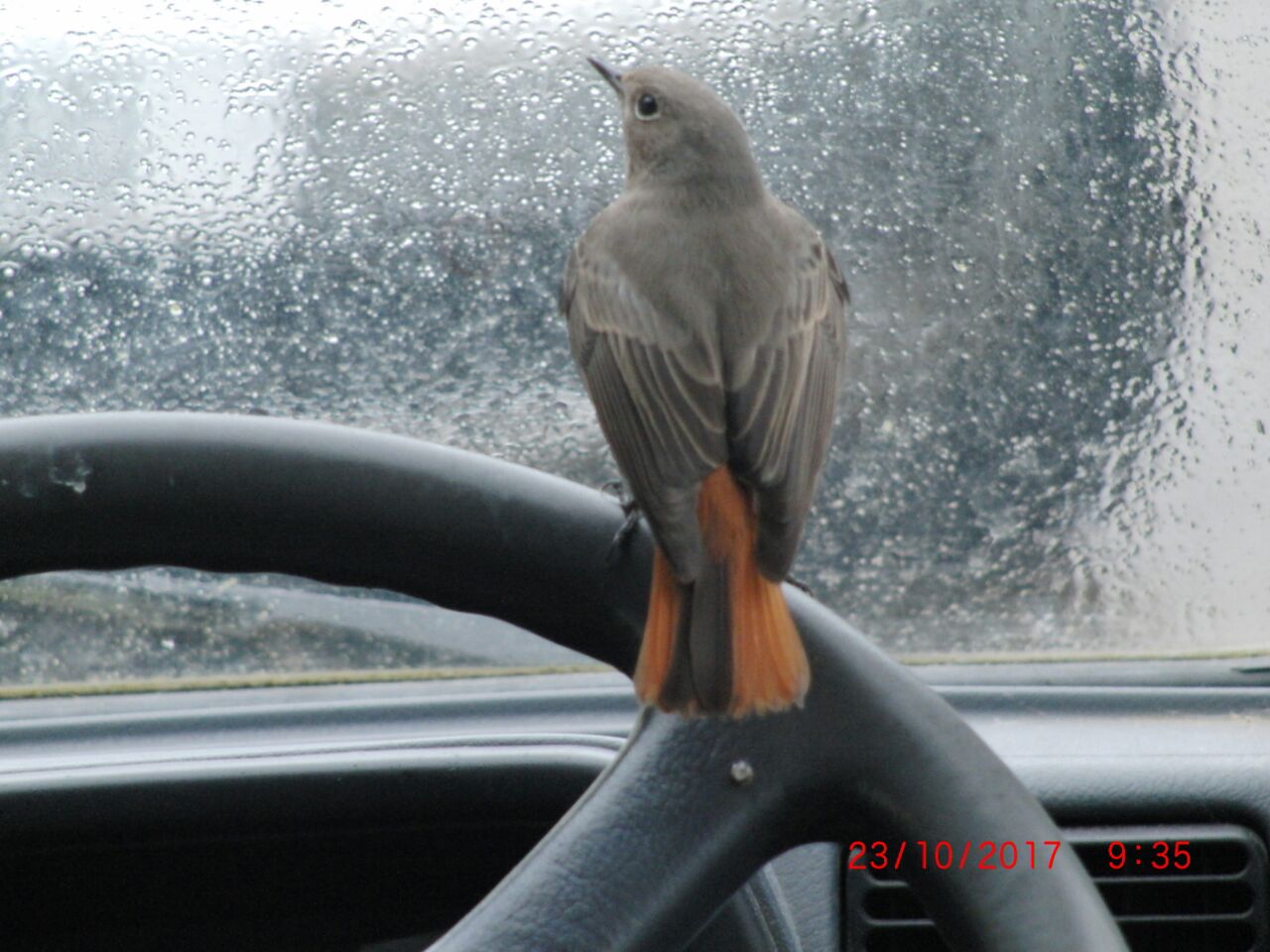
Black Redstart – Longis Bay – photo – Nigel Visard
24th,
Strong winds from the north-west during the morning hampered a late light passage of Swallows involving around 50 birds through. Migrant passerines ringed at Essex farm in the afternoon included Blackcaps, Chiffhcaffs, Goldcrests and Firecrests, of the latter species we have now ringed over 200 ringed this autumn. On the Obs ramparts another Black Redstart.
25th – A Marsh Harrier over Rose Farm. The afternoon saw an dramatic invasion of Goldfinches with some 500 birds in the vicinity of barrackmasters lane. At lunch time there were around 50 Swallows and 2 House Martins on telegraph wires by the frying pan headland. Then followed an amazing 1pm-4pm ringing session using just 2 nets which saw 159 Goldfinches ringed ! A late roost of Swallows at Longis reserve involved at least 150 birds.
26th – Marsh Harrier over Barrackmasters Lane. Again a light but steady passage of Swallows all day. Just before dusk 2 Jack Snipe showed well right in front of Longis nature reserve hide, a Grey Wagatil was also present at the pond. Good numbers of migrants over Rose farm included 20 Skylarks, 40 Siskins and 1000+ Chaffinches. Ringing topped 200 birds again, the highlight a female Hawfinch at Rose farm. Ringing concluded with 17 Swallows at roost on longis reserve.
27th- The winds turned North east overnight and we had a cracking days ringing returning 239 new ringed birds. Two surprises came in the shape of extremely late moving migrants, a Garden Warbler and Lesser Whitethroat. The latter pictured below is an extremely pale brown individual, we considered ssp minula but wing formulae measurements were inconclusive. I’ve certainly never seen one this pale and suspect it to be the eastern superspecies. Redwing (38) and Song Thrush (15) were ringed between Rose Farm and Mannez Quarry. At Mannez visible migration included included 3 Woodlarks, 40 Siskin, 1000+ Redwing & 15 Skylark.
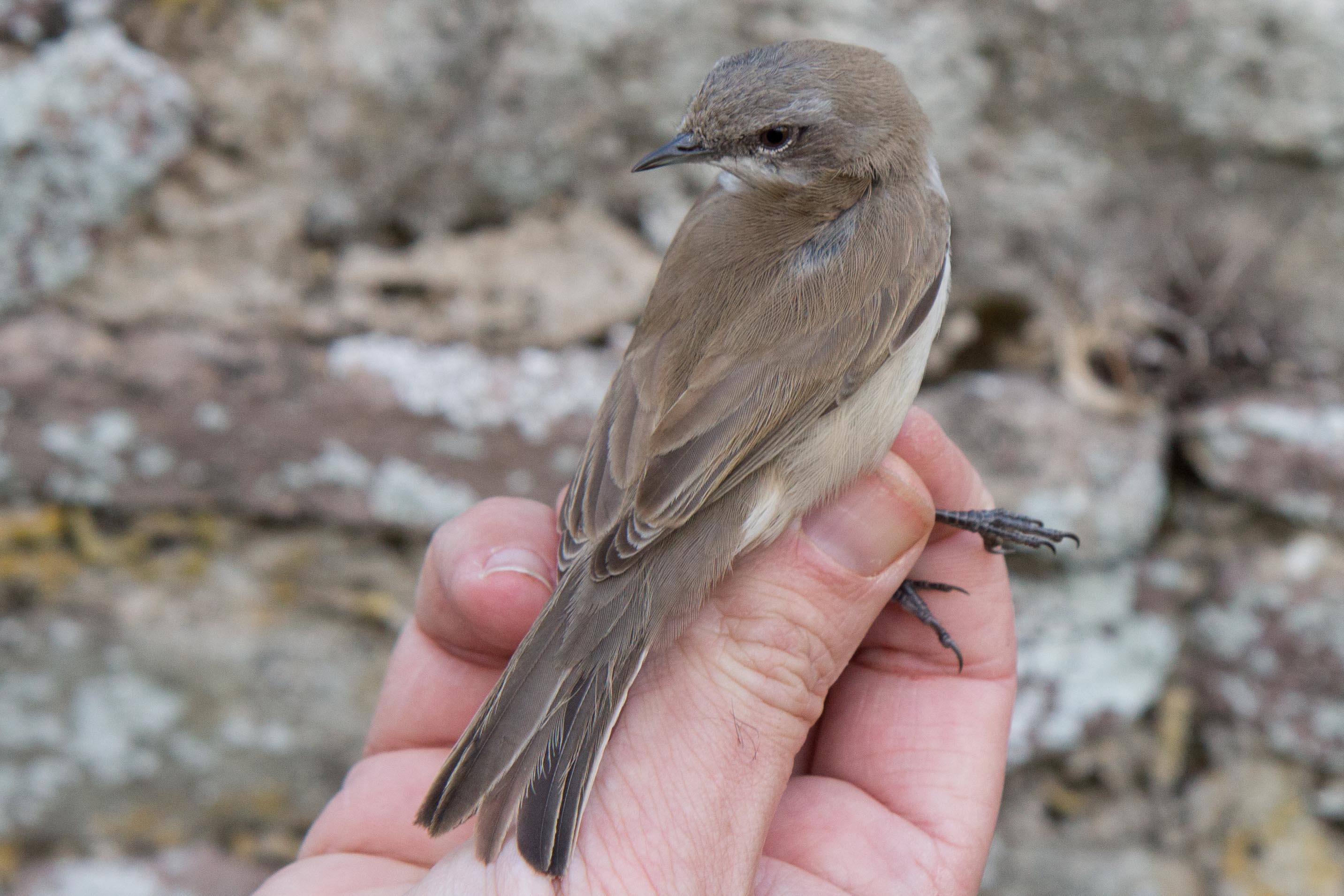
Lesser Whitethroat – Essex Farm – photo – JH – ABO
28th, Hen Harrier in off the sea in Longis bay. An influx of Fieldfares, some 500 over the observatory between 7 & 9 am & at the same time 1 ringed at Longis nature reserve. A busy days ringing saw over 250 birds ringed including a first winter female Penduline Tit at Mannez quarry and a Yellow-browed Warbler ringed at Essex farm along with 4 Lesser Redpolls. Migration overhead also included 2 Bramblings over the Obs (2 were also ringed in Barrackmasters lane) . At Mannez visible migration involved 1000+ Redwings, an estimated 100 Siskins and 4 Hawfinches. A flock of 9 Stock Doves were on Longis common and 2 Sandwich Terns fished Longis bay. Bullfinches have been more frequent this autumn, this fine male pictured below ringed at Essex farm during the afternoon.
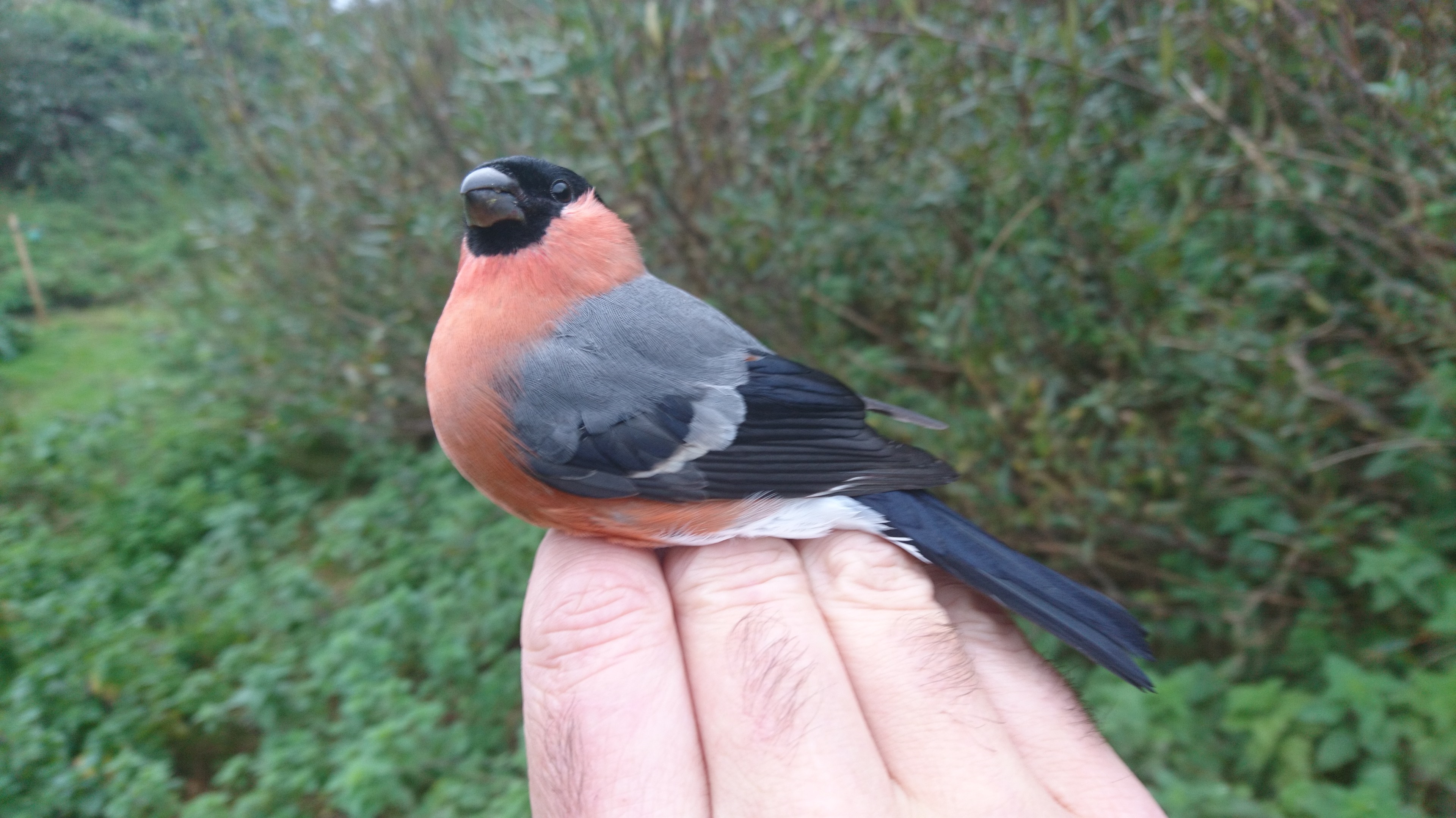
Male Bullfinch – Essex Farm – photo – JH – ABO
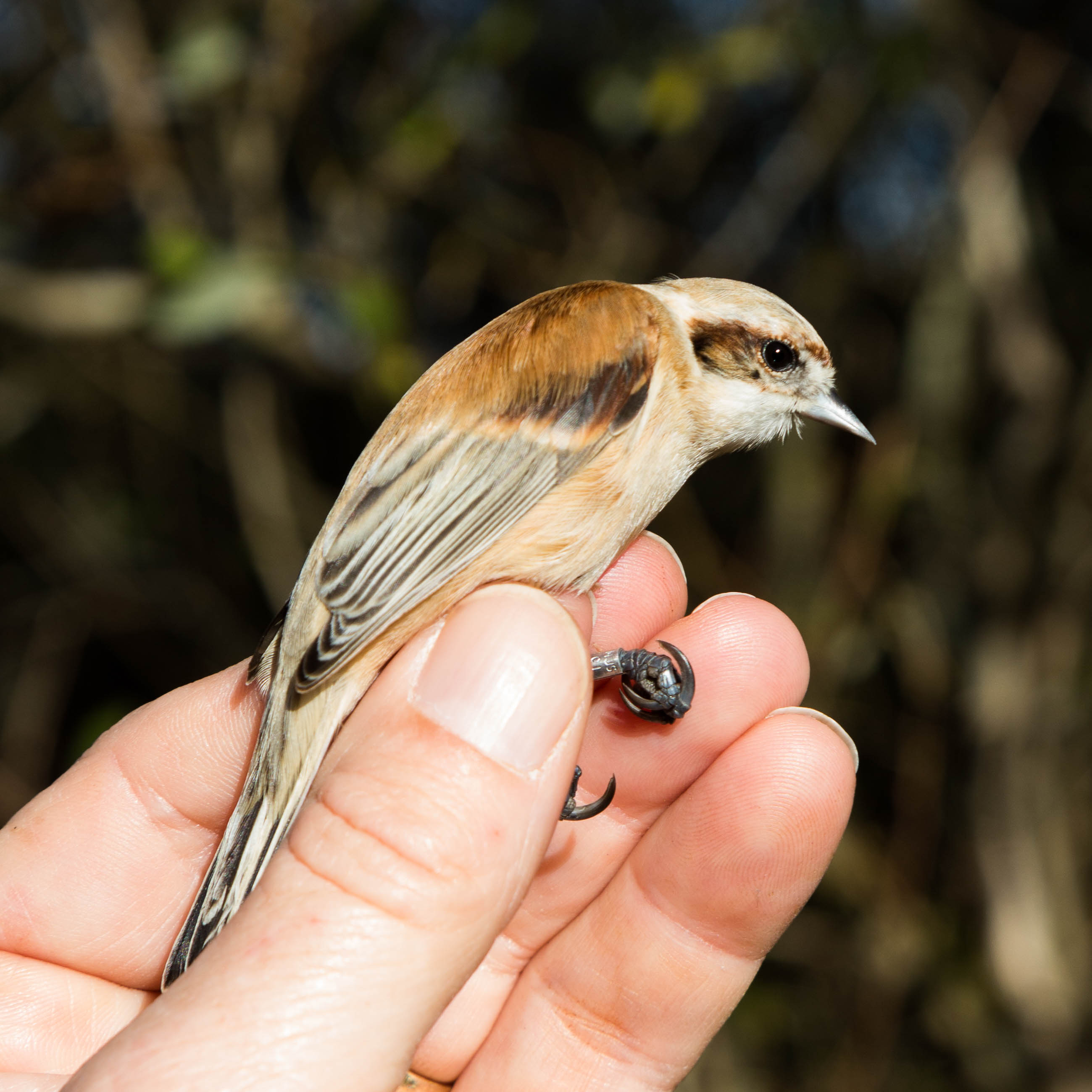
Penduline Tit – Mannez nature reserve – Photo – Paul Veron

Yellow-browed Warbler – Essex Farm – photo – JH – ABO

Male Lesser Redpoll – Essex Farm- photo – JH – ABO
Above two photos of Lesser Redpoll illustrating one of the aging criteria for this species. The photo on the left (tail feathers narrower with more pointed tips) is a 2017 hatch bird, the one on the right, (broader tail with more rounded tips) is an adult.
29th A grey Plover in Braye Bay and a Redshank in Longis Bay. Late afternoon a Mistle Thrush (an unusual migrant here) was on top of the conifers outside the Obs. The Same 2 Sandwich Terns in Longis bay and a further 3 in Braye Bay. Just over 100 birds ringed today brought us to over 1000 in 5 days.
Many thanks to Dr. Manuel Schweizer who reported a sighting of one of our Lesser Black-backed Gull chicks, originally ringed on Burhou island 09/07/16, seen in Switzerland 07/10/17 ! This bird was already interesting because it had been reported in Castellon, Spain 03/11/2016. A few of our Channel Islands born chicks appear to winter in eastern Spain. It is far more common that they are reported in West, South and Central Spain. For the bird to now be seen in Switzerland is unprecedented. Where this bird will go next?! (thanks to Paul Veron for a summery of this data/information)
Lastly, belated news just in of one of the Storm Petrels ringed in 2016 on Burhou Island being re-trapped on Skokholm Island Dyfed. We originally ringed the bird on 29th July 2016 and just 16 days later it was caught 306km away on Skokholm. We’ve had a few exchanges with Storm Petrels re-trapped along the French coast and a handful at the Lizard estuary Cornwall but this is our first to the welsh coast. It’s a real privilege to be at the cutting edge of enhancing the understanding of the movements of Alderneys Storm Petrel colony, amongst one or two other birds !!
























